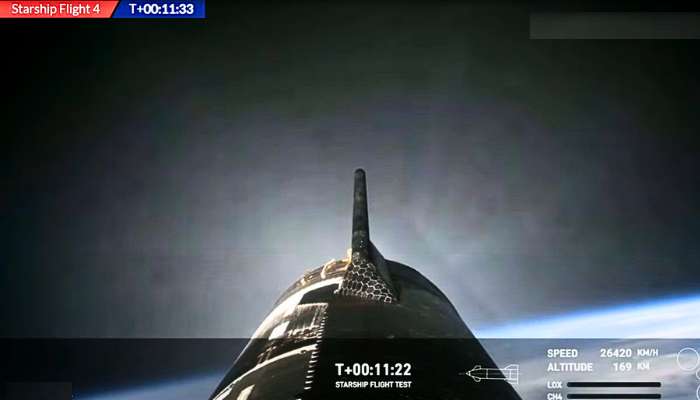The Controlled Splashdown
On June 6, at 8:50 a.m. EDT, the SpaceX Starship soared into the sky on its fourth test flight. The mission aimed to advance the development of the world’s most powerful rocket, pushing the boundaries of reusable space travel.
The Super Heavy Booster, dubbed Booster 11, performed a soft landing in the Gulf of Mexico. The upper stage, Ship 29, also landed softly in the Gulf. This achievement elicited a wave of excitement at SpaceX’s mission control, with employees celebrating the successful splashdown.
Overcoming Past Challenges SpaceX Starship Encountered
The previous test flights had their share of challenges. For instance, Flight 3 faced issues with uncontrolled rolling and engine relight failures. Valve blockages affecting roll control caused these problems.
In response, SpaceX added additional roll control thrusters and upgraded hardware to enhance reliability in future flights.
Similarly, the Super Heavy Booster from the last flight experienced engine shutdowns due to filter blockages. Consequently, SpaceX improved propellant filtration to prevent such issues in Flight 4.
Key Milestone for NASA’s Artemis Mission
Flight 4 was not just a success for SpaceX but also an important step for NASA’s Artemis mission. Additionally, the Starship rocket aims to play a crucial role in the Artemis 3 mission for a crewed lunar landing in 2026.
Moreover, NASA’s Human Landing System program manager, Lisa Watson-Morgan, highlighted the significant advancements made from previous flights and underscored the importance of these tests in refining the rocket’s capabilities.
Future Ambitions from SpaceX Starship
The SpaceX Starship is designed with the long-term goal of enabling human settlement on Mars. SpaceX’s next-gen Raptor engines burn liquid oxygen and methane, vital for sustainable missions. These resources can be sourced locally on the Red Planet.
Before heading to Mars, Starship’s immediate target is the Moon, where it will serve as the lander for NASA’s Artemis missions. The next significant test for SpaceX is to catch the Super Heavy Booster using the launch tower’s “chopsticks” in Flight 5.
Enhancing Launch Capabilities
To support the ambitious launch schedule, SpaceX is building additional infrastructure. Furthermore, a second launch tower is under construction at Starbase, with components being shipped from NASA’s Kennedy Space Center in Florida.
This expansion aims to enable multiple launches per month, thereby accelerating the test campaign and paving the way for more frequent flights.
Propellant Transfer and Future Tests
A critical component of SpaceX’s future missions involves the ability to transfer propellant in space. Consequently, successful demonstrations of propellant transfer are essential for missions to Mars and the Moon, allowing for extended missions and greater payload capacities.
Moreover, SpaceX plans to conduct these tests from multiple launch towers, with NASA closely monitoring the progress.
Conclusion
SpaceX’s Starship program is making remarkable strides, and with each test flight, the dream of reusable, interplanetary space travel comes closer to reality. Furthermore, the success of Flight 4 sets the stage for more ambitious tests and solidifies Starship’s role in NASA’s Artemis mission.
As SpaceX continues to refine and test its technology, the prospect of humans returning to the Moon and eventually setting foot on Mars becomes increasingly tangible.
Watch here : SpaceX Starship lands in Indian Ocean
Also Read : The Boeing Starliner Launch of NASA




